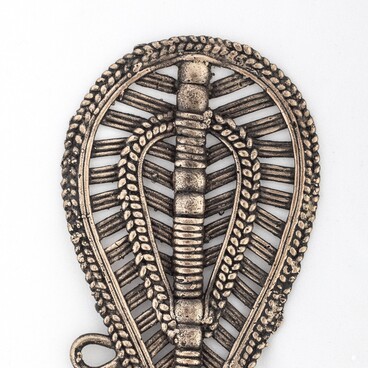In the course of archaeological excavations of multilayered settlement Pereverzevo II (Kursk region, Zolotukhinsky district), which were led by Anna Ivanovna Puzikova in 1983, a very interesting piece of ancient weapons, a sovnya, was discovered.
The sovnya is a polearm with a curved single-bladed tip mounted on a long wooden shaft. The weapon has an elongated subtriangular shape with one sharpened edge. The tip of the blade is missing. The preserved length of the blade is 153 mm, but the blade has been reconstructed by experts to 267 mm. The edges of the sleeve are beveled at an angle of 20˚. The sleeve has a subrectangular hole for attaching the tip to the wooden shaft.
The presence of a massive blade capable of piercing armor indicates that the sovnya is a weapon for close combat. According to Oleg Viktorovich Dvurechensky, an expert on military archaeology, this type of spearheads was a type of armament for foot soldiers, which was used by transport servants and townspeople during siege operations.
Alexander Andreevich Andreev identified tips similar to the one from the collection of the Kursk Museum of Archaeology. They were found during excavations of Belgorod in the layers relating to the late 16th (from 1596) to the 17th centuries, as well as in 1999–2000 during the archaeological study of the Tula Kremlin.
It is worth noting that the term “sovnya” for weapons of this type was first used in the work by the military historian Alexander Vasilievich Viskovatov “Historical description of clothing and armament of Russian troops” of 1841. In the section on Russian arms from the 14th century to the second half of the 17th century the following definition is given:
The sovnya is a polearm with a curved single-bladed tip mounted on a long wooden shaft. The weapon has an elongated subtriangular shape with one sharpened edge. The tip of the blade is missing. The preserved length of the blade is 153 mm, but the blade has been reconstructed by experts to 267 mm. The edges of the sleeve are beveled at an angle of 20˚. The sleeve has a subrectangular hole for attaching the tip to the wooden shaft.
The presence of a massive blade capable of piercing armor indicates that the sovnya is a weapon for close combat. According to Oleg Viktorovich Dvurechensky, an expert on military archaeology, this type of spearheads was a type of armament for foot soldiers, which was used by transport servants and townspeople during siege operations.
Alexander Andreevich Andreev identified tips similar to the one from the collection of the Kursk Museum of Archaeology. They were found during excavations of Belgorod in the layers relating to the late 16th (from 1596) to the 17th centuries, as well as in 1999–2000 during the archaeological study of the Tula Kremlin.
It is worth noting that the term “sovnya” for weapons of this type was first used in the work by the military historian Alexander Vasilievich Viskovatov “Historical description of clothing and armament of Russian troops” of 1841. In the section on Russian arms from the 14th century to the second half of the 17th century the following definition is given:





